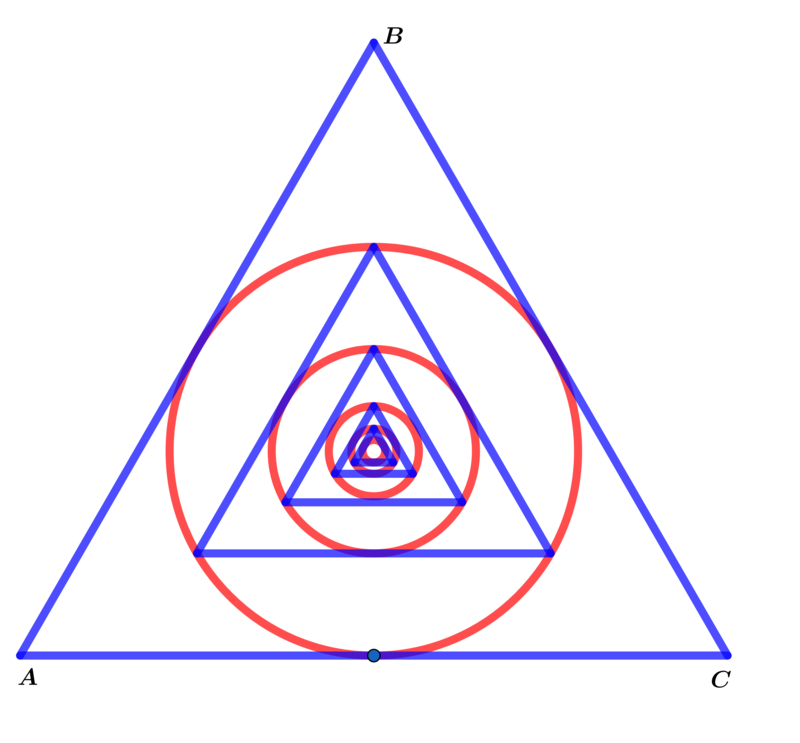Nested Equilateral Triangles and Circles

Starting with equilateral △ A B C the diagram above illustrates nested circles and equilateral triangles. Let A T ( n ) and A c ( n ) be the areas of the n th equilateral triangle and the n th circle respectively.
If A T ( 1 ) ∑ n = 1 ∞ ( A T ( n ) + A c ( n ) ) = b 2 b a ( b b + π ) , where a and b are coprime positive integers, find a + b .
The answer is 7.
This section requires Javascript.
You are seeing this because something didn't load right. We suggest you, (a) try
refreshing the page, (b) enabling javascript if it is disabled on your browser and,
finally, (c)
loading the
non-javascript version of this page
. We're sorry about the hassle.
2 solutions
Let a 1 be a side of equilateral △ A B C .
A T 1 = 4 3 a 1 2
2 a 1 = 2 3 m 1 ⟹ m 1 = 3 a 1 ⟹ h 1 = 2 3 a 1 ⟹ A c ( 1 ) = 1 2 π a 1 2 = 4 ∗ 3 π
2 a 2 = 2 3 h 1 ⟹ a 2 = 3 h 1 = 3 ( 2 3 a 1 ) = 2 a 1 and h 2 = 2 3 a 2 = 2 3 ( 2 a 1 ) = 4 3 a 1 ⟹ A T 2 = 1 6 3 a 1 2 = 4 2 3 a 1 2
2 a 2 = 2 3 m 2 ⟹ m 2 = 3 a 2 = 2 3 a 1 ⟹ h 3 = 2 1 ( 2 3 a 1 ) = 4 3 a 1 ⟹ A c 2 = 4 2 ∗ 3 π a 1 2
Continuing in this manner we have:
A T ( n ) = 4 n 3 a 1 2 and A c ( n ) = 3 ∗ 4 n π a 1 2
T = ∑ n = 1 ∞ A T ( n ) + A c ( n ) = 4 1 ( 3 3 3 + π ) a 1 2 ∑ n = 1 ∞ 4 n − 1 1 = 4 1 ( 3 3 3 + π ) a 1 2 ( 3 4 ) a 1 2 = ( 9 3 3 + π ) a 2 2
and
A T 1 T = 9 3 4 ( 3 3 + π ) = b 2 b a ( b b + π ) ⟹ a + b = 7
That is A T ( n ) = 4 1 A T ( n − 1 ) ⟹ A T ( n ) = 4 n − 1 A T ( 1 ) . Similarly, A c ( n ) = 4 n − 1 A c ( 1 ) .
Then we have:
A T ( 1 ) ∑ n = 1 ∞ ( A T ( n ) + A c ( n ) ) = A T ( 1 ) 1 n = 1 ∑ ∞ ( 4 n − 1 A T ( 1 ) + 4 n − 1 A c ( 1 ) ) = A T ( 1 ) A T ( 1 ) + A c ( 1 ) n = 0 ∑ ∞ ( 4 1 ) n = ( 1 + 3 3 π ) 1 − 4 1 1 = 9 3 4 ( 3 3 + π Note that A T ( 1 ) A c ( 1 ) = 3 3 π
Therefore, a + b = 4 + 3 = 7 .